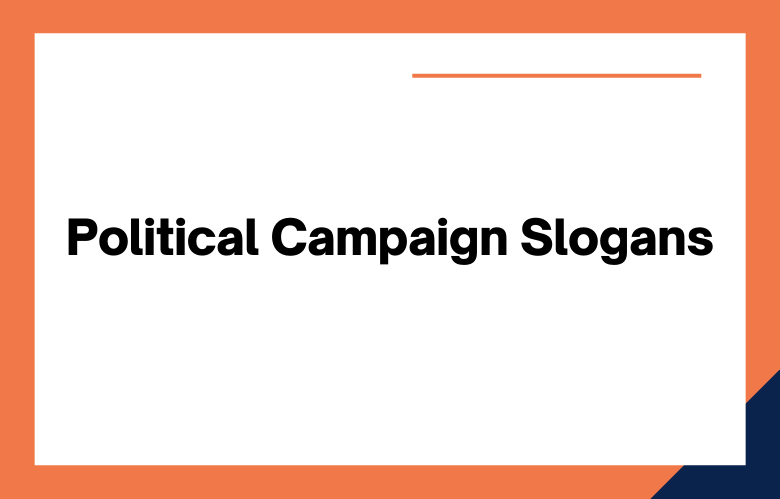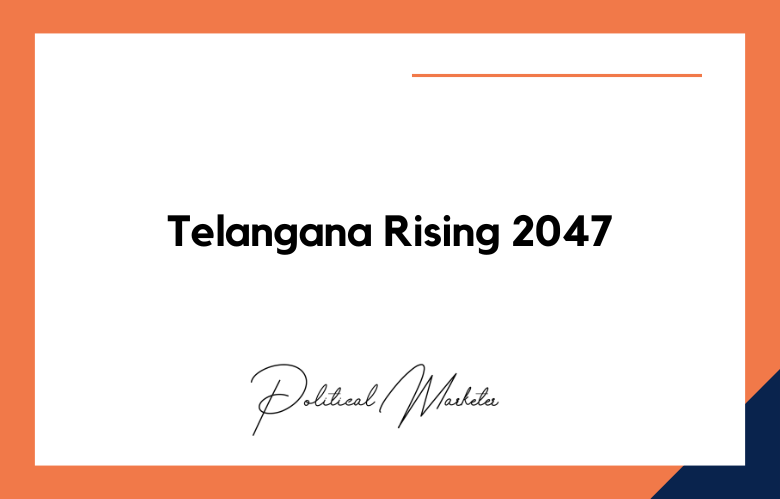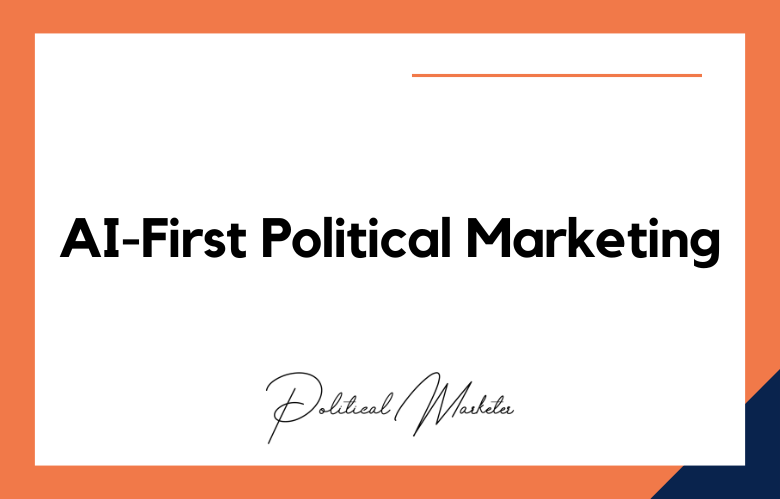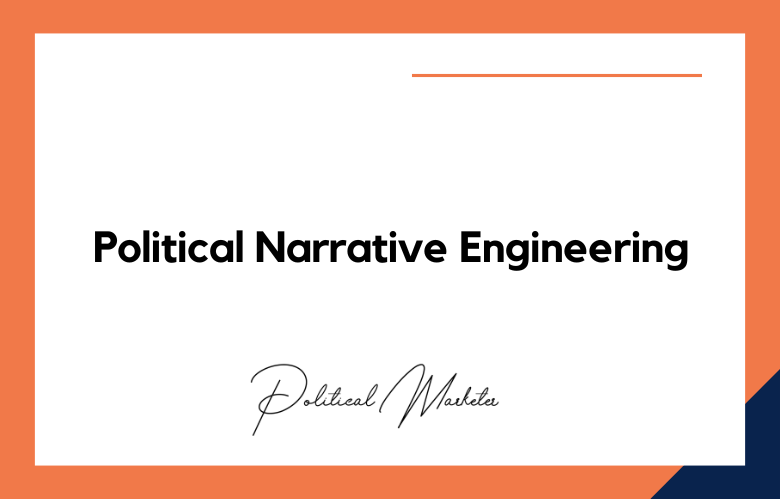Political Campaign Slogans: The rise of political ad campaign slogans and their impact on society can be seen. It can be categorized differently, so you can easily find what interests you the most. There will also be links to other posts about this topic, which may provide additional information or insight.
Social research found that politicians are becoming lazier in their campaigning. They are not willing to do the hard work of coming up with a slogan or platform they can sell to voters, so instead, they steal something from other candidates and hope it sticks. It’s not enough for them to put out a press release saying, “I’m running.” They need a tagline to make people remember who they are. The problem is, most slogans sound as if someone else wrote them – which is usually the case!
What are Political Campaign Slogans?
A campaign slogan is a short, memorable phrase in politics and advertising.
In politics, where people get elected to office, slogans are used as a short idea. Slogans can be for or against any particular political issue.
They are a clever way to advertise and promote your political ideas.
A memorable one-line statement used in political campaign advertising.
Ways To Political Campaign Slogans
Political campaign slogans are short, powerful phrases that capture the essence of a candidate’s message, vision, and values. They serve as a rallying cry for voters, helping to build emotional connection and brand recognition throughout an election campaign.
A well-crafted slogan communicates clarity, credibility, and conviction in just a few words. It reflects the core themes of the campaign such as progress, unity, reform, or empowerment while appealing to the hopes and emotions of the electorate.
Successful political slogans are memorable, adaptable across platforms, and capable of inspiring action. They not only define what a candidate stands for but also influence public perception, strengthen voter loyalty, and set the tone for the entire campaign narrative.
| Aspect | Description |
|---|---|
| Core Objective | To create short, memorable, and persuasive phrases that express a candidate’s message, vision, and appeal to voters. |
| Purpose | To emotionally connect with voters, simplify complex political ideas, and inspire participation or loyalty during elections. |
| Key Characteristics | Simple, clear, emotionally resonant, authentic, and easily repeatable across all campaign platforms. |
| Message Alignment | Reflects the candidate’s ideology, priorities, and values while aligning with the needs and aspirations of the public. |
| Psychological Appeal | Uses emotional triggers such as hope, pride, change, or justice to create a sense of belonging and urgency among voters. |
| Language Style | Employs concise, positive, and action-oriented words that are easy to remember and chant during rallies or debates. |
| Examples | “Yes We Can” (Barack Obama), “Make America Great Again” (Donald Trump), “India Shining” (BJP), “Garibi Hatao” (Indira Gandhi). |
| Design Integration | Used consistently across posters, digital ads, speeches, and merchandise to maintain strong visual and verbal identity. |
| Testing & Feedback | Focus groups, surveys, and social media analytics are used to test slogan resonance and public response before launch. |
| Ethical Use | Slogans must avoid misleading, divisive, or discriminatory messaging to maintain credibility and integrity. |
| Strategic Value | Acts as a unifying theme for campaign communication, helping voters remember and associate the candidate’s identity easily. |
| Outcome | Enhances campaign visibility, improves recall value, and drives emotional engagement leading to higher voter turnout and support. |
How political slogans win elections
When faced with a tough decision, people tend to lean toward the most popular opinion. Party parties focus on creating catchphrases about their party or policies to sway voters.
A slogan is a memorable term that captures the essence of a political candidate or cause. Slogans can be used to create public awareness or make people take action.
How To Create Political Slogans
Have you ever heard anyone say, “I can’t wait to vote!”? Well, it’s time we start saying that. A government by and for the people is a great way to live in any country.
To create effective political slogans, ensure they include the essential points you want to convey. Please do your best to express a single idea in each slogan so people don’t get confused by their length or complexity.
One of the best ways to create political slogans is by being very specific about your policy. For example, if you’re running for office as a Democrat, you must explain how your policies help the middle class.
Why does your campaign need Most Memorable Campaign Slogans?
Creating a slogan is one of the essential parts of running an election campaign. A personal touch can make all the difference when connecting with voters.
Well, you can have a catchy slogan that will stick with people and help make your campaign memorable.
How Campaign Slogans Influence Voting
It’s important to note that not all campaign slogans impact potential voters equally. An example of a saying that
will influence people would be: “Vote for me, and we’ll build a border wall.”
A slogan can influence voting behavior by activating voters’ attitudes toward a candidate.
A recent study shows that campaign slogans have a direct effect on voting. When voters hear the saying more than once, they are more likely to vote for the candidate associated with it.
Political Slogan and Campaign Slogan Ideas
- “Vote Proudly and with Confidence”
- “For the Future of Our Children”
- “I’m with her.”
- “Make __ Great Again.”
- “Stronger Together”
- “___ is already great.”
- “The future is now.”
- “We’re all in this together.”
- “A country that works for everyone.”
- “Together, we’ll make _ great again!”
- “A New Generation of Leadership”
- “I’m in this for you.”
- “We are the future.”
- “Together, we can do more.”
First Impressions Matter
Campaign slogans are the first point of contact between candidates and voters. It is the first thing a voter sees and remembers about a candidate. Therefore, a slogan must be concise, easy to remember, and impactful. A good slogan can create a lasting impression on voters, even if they may forget the candidate’s name. A strong slogan can make a candidate stand out and provide a competitive edge.
Evolution of Political Slogans
Political slogans have evolved from simple rallying cries in print posters and radio broadcasts to sophisticated, data-driven messages amplified through digital platforms. Early slogans focused on patriotism and collective identity, while modern ones emphasize emotion, action, and personal connection. Over time, technological advances, changing voter behavior, and social media dynamics have transformed slogans into strategic tools that shape public perception, influence sentiment, and define the tone of entire campaigns. Today, the evolution of political slogans reflects not just political creativity but also the fusion of psychology, branding, and voter analytics in modern elections.
From Print to Digital Communication
Political slogans have evolved alongside communication technologies. Early campaigns relied on newspapers, posters, and pamphlets to spread short, catchy phrases that reflected national sentiment. During the radio era, tone and delivery became as influential as the words themselves. Television expanded visual storytelling, combining imagery and voice to give slogans stronger emotional appeal. Today, social media platforms and AI-driven analytics shape how slogans are created, tested, and distributed, making them more adaptive and measurable than ever.
Reflecting the Spirit of Each Era
Every generation of political slogans mirrors the public mood and social priorities of its time. Indira Gandhi’s “Garibi Hatao” expressed a commitment to poverty reduction during India’s post-independence reconstruction. Barack Obama’s “Yes We Can” captured global optimism and unity during the late 2000s economic uncertainty. Narendra Modi’s “Acche Din Aane Wale Hain” spoke to aspirations for progress and economic reform. These phrases succeeded because they distilled complex political promises into a few emotionally charged words that resonated with everyday people.
Transition to AI-Powered Messaging
The rise of digital campaigning has turned slogans into data-tested tools of persuasion. Campaign teams now use social listening, sentiment analysis, and natural language processing to assess how voters react to specific words or emotions. AI models help identify which slogans generate the strongest engagement, allowing campaigns to adjust messaging in real time. This evolution has made slogans not just creative expressions but measurable components of voter influence.
From Posters to Hashtags
Slogans once painted on walls or printed on leaflets now circulate as hashtags and short-form videos. Campaigns craft slogans that fit within character limits, sound good when spoken, and are shareable across multiple platforms. For instance, “#YesWeCan” became a digital rallying cry that unified supporters online and offline. Similarly, “#MainBhiChowkidar” extended a slogan into a viral social movement. The medium has shifted, but the purpose remains the same: to make ideas simple, repeatable, and emotionally memorable.
The Modern Role of Slogans
Slogans have transformed from static political statements into dynamic components of a broader campaign strategy. They help define a candidate’s brand, guide media narratives, and frame the emotional context of elections. Modern slogans succeed when they combine clarity, authenticity, and adaptability. Whether printed on a poster or trending online, they continue to influence how voters think, feel, and act during elections.
Psychology Behind Effective Slogans
Effective political slogans tap into human psychology by appealing to emotions rather than logic. They use familiar language, rhythm, and repetition to make ideas memorable and persuasive. Words that evoke hope, pride, unity, or change activate emotional responses that strengthen voter attachment to a candidate. Cognitive simplicity helps people recall the message easily, while emotional framing builds trust and motivation. By combining clarity with emotional resonance, well-crafted slogans shape perceptions, influence decision-making, and drive voter behavior more powerfully than long policy statements ever can.
Cognitive Psychology and Voter Recall
Political slogans work because they connect emotion with memory. Cognitive psychology explains that people remember short, familiar, and emotionally charged phrases better than long or abstract statements. When voters hear a slogan that matches their beliefs or values, their brain processes it faster and stores it as a positive association. This process, known as cognitive fluency, makes the slogan feel natural and trustworthy. Repetition strengthens this recall. The more often a voter encounters a slogan, the more it becomes linked to the candidate’s identity and message.
Emotional Priming and Voter Response
Emotional priming occurs when a phrase triggers an emotional reaction before a person consciously analyzes its meaning. Effective political slogans use this response to shape attitudes and decisions. Hope-oriented slogans such as “Yes We Can” motivate action and optimism, while fear-based appeals like “Stop the Invasion” create urgency and defensiveness. Pride fosters identification with national or group values, and belonging emphasizes shared purpose through phrases like “Together We Can.” Each emotional trigger helps voters form instinctive judgments about candidates and policies.
Psychological Triggers That Drive Persuasion
-
Hope: Encourages optimism and forward thinking.
-
Fear: Alerts people to perceived threats and motivates protective behavior.
-
Pride: Reinforces social identity and collective achievement.
-
Belonging: Builds a sense of community and shared values.
-
Urgency: Pushes immediate action and voter turnout.
Campaigns often combine two or more triggers to balance emotional appeal with rational messaging. For example, slogans that mix pride and urgency can mobilize voters while maintaining a positive tone.
The Role of Simplicity, Repetition, and Positive Framing
Studies in persuasion and advertising consistently show that the most effective slogans are simple, repetitive, and positively framed. Simplicity allows people from diverse backgrounds to grasp the message instantly. Repetition reinforces memory and familiarity, turning slogans into automatic cues for voter preference. Positive framing, such as “Building a Better Tomorrow,” encourages hope and participation, while negative framing risks alienating undecided voters. Rhyming and rhythm further improve recall by engaging both cognitive and emotional processing systems.
How Voters Internalize Slogans
Once a slogan becomes familiar, it shapes how voters interpret new information. A person exposed to a slogan like “For the People” begins to view every policy from that candidate through a lens of empathy and inclusion. This is known as confirmation bias, where slogans prime individuals to interpret facts in ways that reinforce their existing emotions. Campaigns rely on this mechanism to strengthen loyalty and consistency in voter perception.
Linguistic Techniques That Make Slogans Stick
Effective political slogans use language patterns that make them easy to remember and emotionally engaging. Techniques such as rhyme, rhythm, and alliteration enhance recall and create a sense of flow when spoken aloud. Simple sentence structures and familiar words help slogans reach a broad audience, while repetition strengthens association with the candidate or message. Positive and action-oriented language, like “Move Forward” or “Together We Rise,” reinforces motivation and unity. By combining sound, structure, and simplicity, linguistic precision turns a short phrase into a lasting symbol of political identity and persuasion.
Rhyme, Rhythm, and Alliteration
Language structure determines how easily a slogan is remembered. Rhyme creates musicality, making phrases sound pleasing and natural to repeat. Examples like “Better Together” or “Labour and Liberty” stay in memory because the sounds reinforce each other. Rhythm provides flow and pacing, allowing slogans to sound balanced when spoken aloud. Alliteration, the repetition of initial sounds such as “Peace, Progress, Prosperity,” creates a verbal pattern that strengthens recall. These techniques activate the brain’s auditory memory, turning simple phrases into rhythmic cues for persuasion.
Parallelism and Structural Balance
Parallelism gives slogans a sense of order and balance, which the human brain processes easily. It pairs or mirrors grammatical structures to create a clear and predictable pattern. Phrases like “Work Hard. Dream Big.” or “Justice for All.” use repetition in structure rather than sound, which gives them authority and flow. This technique also adds emphasis, helping listeners focus on the intended message without overloading them with information.
Positive vs. Negative Framing
Framing shapes emotional response and determines whether a slogan inspires or alarms. Positive framing, as seen in “Forward Together” or “A Better Tomorrow,” evokes optimism and unity. It encourages voters to associate the campaign with hope and progress. Negative framing, such as “Stop the Lies” or “No More Corruption,” uses contrast to generate urgency and alertness. While effective for mobilizing dissatisfied voters, overuse of negative framing can breed resentment or fatigue. Successful campaigns often strike a balance, using positivity to build trust and limited negativity to drive attention.
The Power of Pronouns and Collective Identity
Pronouns define how voters see themselves in relation to the message. Words like “We,” “Us,” and “Our” invite inclusion, signaling shared purpose and responsibility. They help create a collective identity that binds voters and candidates under a common goal. For instance, slogans such as “We the People” or “Together We Can” transform individual intent into group action. Using inclusive language also reduces social distance between leaders and the public, strengthening emotional connection and voter loyalty.
Simplicity and Familiarity in Language Choice
Beyond structure, effective slogans rely on simple, direct vocabulary. People recall words they already use in daily speech, especially when paired with familiar emotional tones like hope or pride. A slogan that can be understood in one reading and repeated in one breath has greater persuasive power. The combination of simplicity, rhythm, and inclusivity ensures that a slogan is not just heard but remembered and repeated—making it one of the most durable tools in political communication.
Social Media and Digital Amplification
Social media has transformed political slogans from static phrases into dynamic tools of mass engagement. Platforms like X, Instagram, and YouTube allow campaigns to test, refine, and amplify slogans in real time. Hashtags, memes, and short videos turn a few words into viral symbols that reach millions within hours. Data analytics and sentiment tracking help measure public response, ensuring slogans stay emotionally relevant and adaptive. This digital amplification gives modern campaigns the power to shape conversations, influence perception, and sustain voter interest far beyond traditional rallies or advertisements.
Extending Reach Through Hashtags, Memes, and Short-Form Videos
Social media has turned political slogans into participatory tools of communication. Hashtags allow supporters to spread a unified message across multiple platforms, making slogans visible in trending discussions and search results. Memes transform slogans into visual humor or symbolism, helping campaigns reach younger audiences who engage more through images than text. Short-form videos on platforms like Instagram Reels, YouTube Shorts, and TikTok compress political emotion and identity into seconds, allowing slogans to reach millions through organic sharing and algorithmic boosts. The combination of these formats gives slogans an immediacy and accessibility unmatched by traditional media.
Testing and Refining Through Data
Modern campaigns use data-driven methods to evaluate slogan effectiveness before mass rollout. A/B testing allows teams to compare multiple versions of a slogan across different audiences to identify which wording produces stronger engagement or emotional response. Sentiment analysis tracks how people react to slogans online by measuring tone and context in comments, shares, and replies. Social listening tools collect real-time data from online conversations, revealing how slogans perform across demographics and regions. These insights help campaigns refine language, emotional appeal, and timing to ensure maximum voter resonance.
Virality and Public Perception
Virality reshapes perception faster than any rally or press event. A slogan that gains traction online through repetition, parody, or advocacy becomes part of everyday conversation. Viral slogans often transcend their political origins, turning into social expressions that reinforce identity and belonging. This rapid spread influences voter sentiment by normalizing a candidate’s message and framing public debate. The faster a slogan circulates, the more it defines the campaign’s tone and shapes collective attitudes, making social media not just a tool for amplification but a battlefield where perception and persuasion unfold in real time.
The Digital Feedback Loop
Every share, comment, and repost adds to a feedback cycle that amplifies a slogan’s life span. Campaigns monitor this digital behavior to adapt their communication strategy instantly. When slogans trend online, they generate press coverage, memes, and public debate, extending their influence far beyond paid advertising. Social media thus transforms slogans from passive taglines into living narratives that evolve with audience participation, shaping both campaign momentum and voter emotion.
AI and Data-Driven Slogan Testing
Artificial intelligence has revolutionized how political campaigns craft and evaluate slogans. Instead of relying on intuition or small focus groups, campaign teams now use AI tools to analyze voter sentiment, linguistic tone, and emotional resonance. Machine learning models process data from social media, surveys, and speech transcripts to identify which words or emotions connect most with target audiences. Natural language processing helps test variations of slogans for clarity, memorability, and emotional impact. By combining analytics with automation, AI enables campaigns to predict which slogans will inspire trust, engagement, and voter turnout before they are publicly launched.
How AI Analyzes Voter Sentiment
Artificial intelligence allows campaigns to understand what resonates emotionally with voters before launching a slogan publicly. Machine learning models analyze millions of online conversations, posts, and reactions to detect tone, sentiment, and intensity. These insights reveal whether voters associate certain words with trust, anger, pride, or hope. Campaign teams use this data to identify language patterns that attract or repel specific voter segments. By quantifying emotional response, AI transforms slogan creation from guesswork into a measurable, evidence-based process.
Using NLP and Emotion Detection for Slogan Refinement
Natural Language Processing (NLP) helps campaigns study how words influence interpretation and recall. NLP tools analyze grammar, phrasing, and semantic structure to predict how a slogan will sound and feel to different audiences. Emotion detection algorithms extend this by evaluating subtle cues such as positivity, fear, enthusiasm, or skepticism embedded in online comments and survey responses. If a slogan evokes the wrong reaction, AI models recommend adjustments in tone, length, or vocabulary. This process allows campaigns to refine messaging until it achieves the ideal emotional and cognitive impact.
AI Tools for Testing Emotional Resonance
Campaigns now rely on specialized AI software to simulate and measure public reaction. Platforms like ChatGPT and Jasper assist in generating slogan variations and testing phrasing for tone, rhythm, and clarity. Brandwatch and similar analytics tools monitor how audiences respond across social networks, identifying which slogans drive engagement or controversy. Predictive models then rank slogans by potential effectiveness, allowing teams to choose those most likely to inspire confidence and participation.
The Strategic Impact of Data-Driven Testing
AI-driven testing changes how political campaigns approach communication strategy. Instead of waiting for polls or focus groups, campaigns receive real-time feedback on voter emotion and engagement. This speed enables teams to adapt slogans during critical campaign moments, ensuring messages stay relevant and persuasive. Data-backed slogans also strengthen credibility by reflecting the actual language and concerns of voters, not just campaign rhetoric. By merging creativity with computation, AI ensures that every word in a political slogan serves a clear purpose, capturing emotion, signaling intent, and driving voter connection.
A Call to Action
Finally, a slogan is a call to action that persuades citizens to vote for a candidate. A good slogan can inspire people to get involved in a campaign by joining the candidate’s movement, donating money, or voting. Slogans like “Hope” during Barack Obama’s campaign or “Feel the Bern” during Bernie Sanders’ campaign were rallying cries that motivated voters to take action.
Conclusion
The power of a political slogan can be immense. Slogans have been used to create memorable phrases that are still used today. Whether you’re running for office or want to make your message more effective and engaging, knowing how people react when hearing these five campaign slogans is essential. Contact us if you need help creating catchy political campaign slogans.
A good slogan is vital to a successful political campaign. It can be used as an effective branding technique or to establish the party’s values and goals for voters.
Slogans should concisely convey what you are trying to communicate with your base voter group while appealing to undecided voters who may not have strong feelings about your candidate but would like clarity before they vote. Contact us today if you need help creating a memorable and impactful slogan for your next election cycle!
Political Campaign Slogans: FAQs
What Is A Political Campaign Slogan?
A political campaign slogan is a short, memorable phrase that summarizes a candidate’s message, values, or vision in a way that connects emotionally with voters.
Why Are Political Slogans Important In Elections?
Slogans shape public perception by simplifying complex political messages into words that are easy to remember and repeat, helping candidates build identity and recognition.
How Do Political Slogans Influence Voter Behavior?
Effective slogans trigger emotional responses such as hope, pride, or urgency, guiding voters to associate those emotions with the candidate or party.
What Makes A Political Slogan Successful?
A successful slogan is simple, clear, emotionally engaging, and aligned with the campaign’s core message. It must resonate with the audience and inspire action.
How Do Candidates Develop Their Slogans?
Campaign teams use research, focus groups, and increasingly AI-driven tools to test phrases that best match voter sentiment and campaign goals.
What Role Does Emotion Play In Political Slogans?
Emotions drive memory and motivation. Slogans that evoke strong feelings like optimism, unity, or justice are more likely to stay in voters’ minds.
Can A Slogan Determine The Outcome Of An Election?
While not the sole factor, a powerful slogan can significantly influence public engagement, media coverage, and voter turnout.
How Do Modern Campaigns Test Slogan Effectiveness?
They use A/B testing, sentiment analysis, and social listening to measure how audiences react to different versions of slogans in real time.
What Are Examples Of Famous Political Slogans?
Well-known examples include “Yes We Can” (Barack Obama), “Make America Great Again” (Donald Trump), and “Garibi Hatao” (Indira Gandhi).
How Has Technology Changed Slogan Creation?
AI and data analytics now help campaigns identify emotional triggers, refine language, and predict which slogans will perform best across digital platforms.
What Linguistic Techniques Make Slogans Memorable?
Rhyme, rhythm, alliteration, and repetition help slogans sound catchy and stay in memory longer.
How Does Framing Affect A Slogan’s Impact?
Positive framing, such as “Forward Together,” promotes unity and optimism, while negative framing, like “Stop The Lies,” appeals to urgency and action.
Why Are Short Slogans More Effective?
Short slogans are easier to recall, share, and repeat across platforms, making them ideal for both traditional media and social networks.
How Do Slogans Differ Across Regions Or Cultures?
Cultural values, language, and local issues shape how slogans are written and interpreted, especially in multilingual countries like India.
What Ethical Issues Arise With Political Slogans?
Slogans that mislead, divide, or promote hate can damage public trust and undermine democratic discourse.
Can A Slogan Evolve During A Campaign?
Yes. Campaigns often refine or adapt slogans as public opinion shifts or as new issues emerge.
How Do Social Media Platforms Amplify Slogans?
Hashtags, memes, and short videos spread slogans rapidly, turning them into viral movements that extend campaign reach.
What Is The Difference Between A Slogan And A Tagline?
A slogan is issue-driven and campaign-specific, while a tagline reflects long-term identity, often used by political parties across multiple elections.
Do Opposition Parties Respond To Each Other’s Slogans?
Yes. Competing parties often counter slogans with alternate versions that challenge or mock their opponents’ messages.
How Can Future Campaigns Use AI To Improve Slogans?
AI can analyze voter sentiment, simulate emotional reactions, and generate multiple slogan variations to find the one most likely to connect with diverse audiences.
One way to get in touch is by filling out our online form on this site or give us a call at +919848321284. Let’s work together today!











